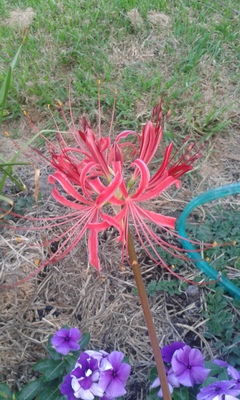When I went out to the garden today I was delighted to see the first of the nerines I transplanted from a pot last May, in flower.
I have read somewhere that they like to bake in their dormant phase so they certainly have had ideal conditions this summer!
Like many of the flowers that do well in this area, they are a native to South Africa.
There are 23 species of these mainly autumn flowering bulbs and with careful selection and some persistence and detective work around suppliers, it is possible to have various forms flowering well into winter.
I haven’t been persistent and only have one large clump that I rescued from a garden clean up.
Mine are the common deep pink with the strappy leaves being dark green with a lighter stripe up the centre.
I do know they come in a variety of colours from white through pink to red/orange and are often referred to as Spider Lilies. I plan on trying to find “Alba,” a white variety that will flower in May and “Winter Cheer,” a strong pink that will flower in June and add colour and provide cut flowers when there is little else. An elderly friend in Manilla had a lovely creamy yellow variety that I always meant to get but unfortunately I left my run too late and the house has been sold.
The common name, used mostly in Europe, is the Guernsey lily, and came about because they were found growing wild on Guernsey probably having washed up from shipwrecks.
Nerine is from the sea nymph Nereis and celebrates the same origin. They are a member of the Amaryllis family.
Apparently they can be evergreen, however the ones I have send up the flower spike with no sign of leaves until later.
They grow very much like belladonna lilies (naked ladies) that I also have as rescue plants.
With these particular bulbs I didn’t really know what I had so just put them in pot and waited. I had a nice surprise last week when a stem came up and flowered, so now I need to find a spot where they can remain undisturbed and put them in.
On trips to family in WA, I have seen belladonnas naturalised in large clumps in paddocks beside the road where they look lovely, but are probably considered noxious!
Similarly I have seen common white arum lilies doing very nicely in damp areas in the eastern states and in the west and they are definitely a reportable weed in WA where they were introduced from South Africa as a garden plant.
Once again we are reminded that a weed is only a plant out of place!
Lycoris, very closely related to the nerine, both being members of the Amaryllidaceae family, is native to eastern Asia, mainly China and Japan.
I am no expert so can’t tell the difference between these plants and am inclined to think the yellow ones I spoke of earlier were Lycoris.
As with nerines and belladonnas they like to be planted in well drained gritty soil with their necks exposed.
I certainly won’t discriminate and will be happy to plant either lycoris or nerines in my garden when I find them as they are so easy and hardy.
I will definitely hunt down the yellow one my friend had as even though it will not be from her garden it will remind me of her wonderful friendship over many years.
In a recent column I said that next year I planned on having an extended vegie garden. Well it is underway!
I had visit from my son and family this week and he has made two beds out of sleepers.
Now I just need to get them aligned exactly where I want them, staple black plastic to the inside of the sleepers to prevent any of the treatment chemicals leaching into my vegie patch, treat the ground with some Earth Life Garden Mate to break up the clay and condition the ground, fill them with soil and they will be ready to fill with plants in the spring! Wonderful!
I also have plans and a position set aside for a compost tumbler and maybe a worm farm. Good things are happening!
Here is the trivia for this week.
According to the most recent study by Dr. Crowther from Yale University, there are three trillion trees on earth. This equates to more than 420 trees for each person!
While this is an astounding number, we continue to remove 15 billion trees per year and only plant five billion.
To maintain the status quo, we would each need to plant two trees.
An old Greek proverb says: “A society grows great when old men plant trees in whose shade they know they will never sit.”







